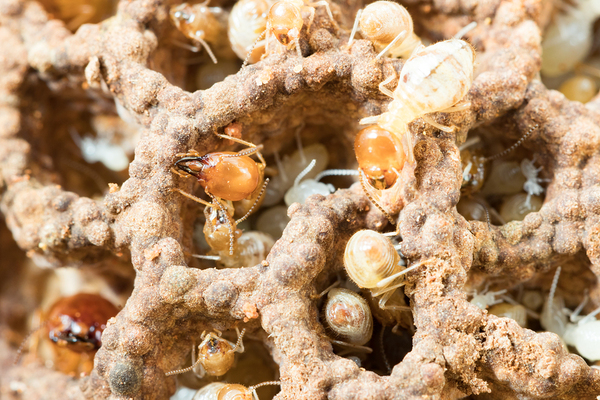
Termites are a particularly dreaded wood-destroying organism.
As a home inspector, it’s important that you have an understanding of the types of wood-destroying organisms and how to identify them. Most homes are made of wood, and these creatures can do significant — and sometimes irreparable — damage to a home.
Even a home made of brick or stucco is not safe. Bugs can infiltrate the home and take up residence in window frames, doors, walls, or any part of the home that’s made of wood.
Termites
When we think of wood-destroying organisms, often the first ones to come to mind are termites. Termites are insidious, because all too frequently, homeowners are unaware of their presence. This is because termites burrow deep within wood and feed on the pulp, largely unnoticed.
In this manner, they can do extensive damage, eating large sections of a home’s framing or finish work without the homeowner’s knowledge. Replacing these wooden parts of a home can be expensive, and it’s hard to know when the problem has been thoroughly eradicated.
As a home inspector, if you see small, flying insects flocking to light or if you notice insect wings on the floors near windows, this is a telltale sign of a termite infestation. Even more telling are their distinctive trails, which look like tunnels made out of mud.
Finally, if parts a home make a hollow noise when you knock on them, this could also be a sign that termites have eaten the interior structure.
Beetles
Some species of beetles also destroy wood. They can be found in homes or wooden furniture or other outdoor structures. These beetles burrow into the wood and deposit their larvae. When the baby insects hatch, they emerge, leaving small holes behind. Thus, signs of a wood-eating beetle infestation include tiny holes similar to nail holes in a deck or other places in the home.
These pests are more often attracted to old or decaying wood. To cut down on tempting this insect to take up residence, it’s best to dispose of any unused scrap wood or lumber.

Carpenter ants destroy wood by excavating areas for the colony to live.
Ants
While carpenter ants don’t eat wood, they can destroy it in the course of establishing a colony inside a wooden structure. Carpenter ants prefer wood that is moist and partially decayed. Signs of a carpenter ant infestation include shavings on the floor or ground beneath where they are building their nest.
Once the colony grows to a certain size, you can even hear them working inside the wood to expand their living quarters. Witnessing carpenter ants emerging from cracks or holes in walls or ceilings is a fairly sure sign of an infestation.
Bees
Wood, or carpenter, bees also burrow into lumber and destroy it. Favorite targets are decks, sheds, and attics. Telltale signs of a carpenter bee infestation are pinky-finger-sized holes in wood that appear to have been drilled with a power tool — that’s how smooth and even they are. Some also have sawdust underneath.
Similar to a carpenter ant infestation, with a carpenter bee infestation, you may be able to hear the colony working inside the wood.
Fungus
Lastly, fungus, while not an insect, is a living thing that can also destroy wood. There are two basic kinds of wood-destroying fungus — dry rot and wet rot. Both thrive in damp and humid conditions, but they look different.
Wood affected by dry rot has a whitish-yellowing tinge and an odor. Wood that is affected by wet rot may look darker, but if it is painted, you may not notice any change. The only way to diagnose wet rot is to probe the wood to see if it yields or has a spongy feel.
Dry rot spreads faster than wet rot, but both must be removed and replaced to stop progression. And the source of the problem must be rectified so that the problem does not return. Sometimes this is done by repairing leaks, improving ventilation or adding a humidifier.
Home Inspection Courses
ICA’s home inspection courses teach you everything you need to know about becoming a home inspector, including how to spot the presence of wood-destroying organisms. Get a demo of our home inspection course today.







